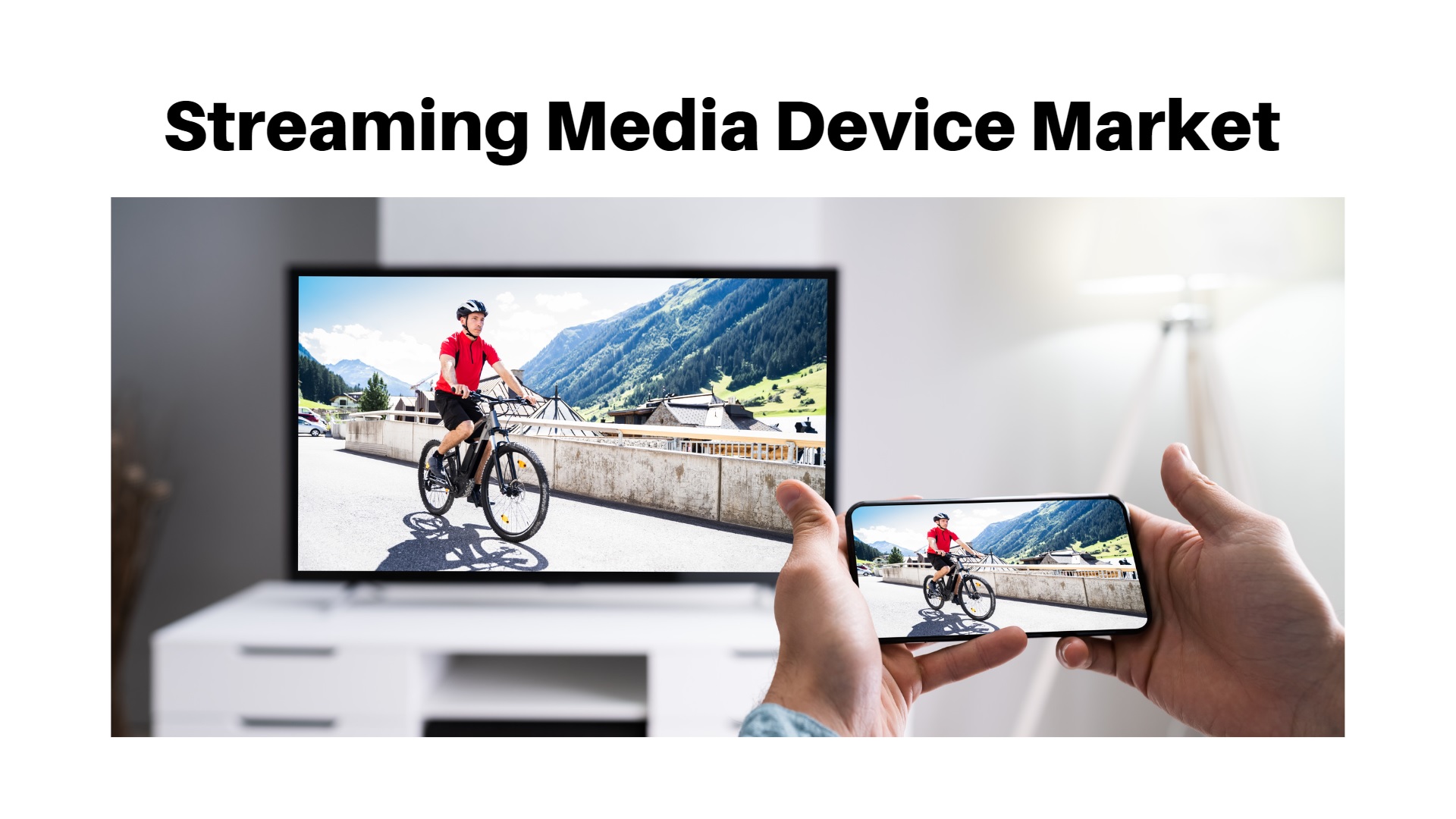Global Streaming Media Device Market To Accrue Nearly USD 1229.68 Bn By 2033

Page Contents
Market Overview
Published Via 11Press: A streaming media device is a hardware device that enables users to stream digital content, such as TV shows, movies and music from the internet to their television. They typically connect to your television through an HDMI port and access to the internet either through Wi-Fi or Ethernet connections. As more consumers have cut the cord on traditional cable or satellite TV services in favor of streaming options like Netflix, Hulu or Amazon Prime Video. streaming media devices Market provide access to an extensive library from popular streaming services like Netflix, Hulu and Amazon Prime Video plus live TV streaming services like Sling TV or YouTube TV.
The Streaming Media Device Market size is expected to reach USD 1229.68 Bn by 2033, up from its current value of USD 214.78 Bn in 2022, growing at an annual compound growth rate (CAGR) of 17.19% from 2023-2033.
Most streaming media devices feature their own operating systems, user interfaces, and app stores that let users customize their viewing experience and access a wide variety of content. Many devices also provide advanced features like voice control, 4K resolution and HDR support to offer users a superior viewing experience. The streaming media device industry is highly competitive, featuring a diverse group of players such as major tech giants like Amazon, Apple, and Google alongside smaller startups like Roku or Nvidia.
The industry is expected to experience continued growth over the coming years as more consumers switch from traditional TV services to streaming options. Streaming media devices have seen a meteoric rise in popularity over the last few years, as more consumers opt to cut the cord and rely on streaming services for their entertainment needs. They provide an accessible, convenient way to access various types of content – from movies and TV shows to music and podcasts – at reasonable costs.
Key Takeaways
- Streaming media devices enable users to stream digital content directly from the internet onto their TV screen. There are various types of streaming media devices, such as smart TVs, streaming sticks, set-top boxes, gaming consoles and media PCs. Streaming media offers a convenient and affordable way for individuals to access various types of media like movies, shows, music and podcasts.
- Streaming media devices typically connect to a TV through an HDMI port and access the internet through Wi-Fi or Ethernet. Some offer advanced features like 4K resolution and faster processing, while others are simpler and more affordable options. While many modern TVs come with built-in streaming capabilities, users may still opt for purchasing separate streaming media devices for extra capabilities and flexibility. As more consumers cut the cord and rely on streaming services for entertainment needs, streaming media devices have become more commonplace.

Click Here To Access Sample Pages Of This Report: https://marketresearch.biz/report/streaming-media-device-market/request-sample/
Regional Snapshot
- Streaming media devices have seen a meteoric rise in popularity throughout North America, particularly the United States and Canada. The three most popular streaming players in this region are Amazon Fire TV, Roku, and Apple TV.
- Streaming media devices are becoming more and more commonplace in Europe, with Amazon Fire TV and Google Chromecast topping the list of top choices.
- Streaming media devices are becoming more and more commonplace across Asia-Pacific, particularly countries like India, Japan and South Korea. Popular options include Amazon Fire TV Stick, Google Chromecast and Xiaomi Mi Box.
- Streaming media devices are becoming more and more commonplace in Latin America, with the Amazon Fire TV Stick and Roku being two of the most popular options.
- Streaming media devices are still relatively new to the Middle East and Africa, but they're quickly gaining ground. Popular options in this region include Amazon Fire TV Stick and Google Chromecast.
Enquire Here & Query for report: https://marketresearch.biz/report/streaming-media-device-market/#inquiry
Drivers
- Increasing Demand for Digital Content: As more people rely on streaming services to fulfill their entertainment needs, the demand for streaming media devices has skyrocketed. Consumers want a simple and affordable way to access digital content on their TVs, which streaming media devices provide.
- Cord-Cutting Trend: The growing trend of cord cutting, or canceling traditional cable and satellite TV subscriptions, has also driven the growth of streaming media devices. Consumers are seeking alternatives to traditional TV services and streaming media devices provide instant access to a vast library of digital content without needing an expensive traditional TV subscription.
- High-Speed internet Accessibility: High-speed internet has been a major factor in the growth of streaming media devices. Thanks to faster connection speeds, consumers are now able to enjoy digital content on their televisions more conveniently than ever before.
- Technology Advancements: As streaming media devices become more powerful and affordable over time, they have become more accessible to a wider range of consumers. Furthermore, advances in technology have enabled streaming media devices to offer advanced features like 4K resolution and voice control.
- Competition Deepens: As more companies enter the streaming media device market, competition has heated up, spurring innovation and improved products. Furthermore, this has caused prices to come down, making streaming media devices more accessible for consumers.
Restraints
- Streaming media devices require a stable and fast internet connection for optimal performance. If your area has poor internet coverage or slow speeds, streaming media devices may not function properly, leading to frustration for users. Though streaming media devices have become more affordable over time, some consumers may still find the cost of these devices an impediment to adoption. Furthermore, some people may hesitate to invest in a new device when their TV already has built-in streaming capabilities. Furthermore, some content providers place restrictions on how their content can be streamed, which could restrict certain shows or movies available on streaming media devices.
- Some users may find certain streaming media devices difficult to use or confusing, which could negatively affect adoption and usage rates. Furthermore, streaming media devices may pose security risks, particularly if users are streaming content from unknown or untrusted sources – this poses a concern for both personal and corporate users alike. Despite their growing popularity, there remain obstacles which could prevent widespread adoption such as internet connectivity issues, cost issues, content licensing restrictions, user interface design and ease of use issues plus security worries.
Opportunities
- Streaming media devices have viewed a meteoric upward push in reputation around the world, but there stays room for similarly international expansion. As more nations build and upgrade their net infrastructures, demand for streaming media devices is anticipated to only grow. Streaming media units can be integrated with different clever home technologies, like voice assistants and domestic automation systems, for a more seamless and convenient enjoyment experience for users. Streaming media machine manufacturers have the opportunity to create original content material in order to differentiate their devices and entice new users. Companies like Amazon and Apple have already invested heavily in this trend, which is likely to continue.
- Streaming media units could probably combine with augmented truth and virtual fact technologies, imparting customers with an immersive entertainment experience. Furthermore, streaming media devices provide content material carriers the chance to reach a wider target market and generate income through marketing or subscription-based models.
Challenges
- As more companies enter the market, competition has grown more fierce and made it increasingly difficult for new entrants to establish themselves. Furthermore, streaming media technology is rapidly developing which could make it challenging for businesses to stay abreast and remain competitive. Furthermore, with so many different streaming media devices and services available, users may feel overwhelmed by all of the options and have difficulty selecting one that meets their individual needs.
- Streaming media devices can be exploited for illegal streaming and piracy, which harms the industry and discourages content creators from creating new material. As streaming media devices collect data on user behavior, privacy concerns have grown increasingly pressing. Companies must take measures to safeguard user data and demonstrate transparency in their data collection and usage practices. Licensing and distribution of digital content can be complex, with content providers often placing limitations on how it can be streamed or accessed – meaning certain shows or movies may only be accessible through certain streaming media devices.
- The streaming media device industry faces numerous obstacles, such as growing competition, rapid technological change, fragmentation, content piracy, privacy concerns and licensing/distribution problems. Companies must navigate these difficulties in order to remain competitive and ensure the continued growth and adoption of streaming media devices.
Market Segmentation
Streaming Media Device Market, by Type
- Game Consoles
- Media Streamers
- Streaming Box/Media Player
- Plug-in USB Sticks/ Streaming Sticks
- Smart TV’s
Streaming Media Device Market, by Application
- Gaming
- Real-time Environment
- Social Networking
- E-Learning
- Web Browsing
- Streaming Media Device Market, by End-Use
- Commercial
- Residential
Key Players
- Google, Inc.
- Microsoft
- Sony Corporation
- Roku, Inc
- Samsung Electronics Co.ltd.
- ASUSTeK Computer Inc.
- LG Electronics, Inc.
- Apple, Inc.
- Philips Electronics
Report Scope
| Report Attribute | Details |
| Market size value in 2022 | USD 214.78 Bn |
| Revenue forecast by 2033 | USD 1229.68 Bn |
| Growth Rate | CAGR Of 17.19% |
| Regions Covered | North America, Europe, Asia Pacific, Latin America, and Middle East & Africa, and Rest of the World |
| Historical Years | 2017-2022 |
| Base Year | 2022 |
| Estimated Year | 2023 |
| Short-Term Projection Year | 2028 |
| Long-Term Projected Year | 2033 |
Growing Demand => Request for Customization
Recent Developments
- Integration with gaming platforms: Some streaming media devices, such as the Amazon Fire TV, are now integrating with gaming platforms to offer users a more immersive entertainment experience.
- Voice control and personalization: Many streaming media devices are now offering voice control capabilities, making it easier for users to navigate and find the content they want. Additionally, some devices are incorporating personalization features, such as recommendations based on user viewing history.
- Expansion into emerging markets: Streaming media device manufacturers are increasingly expanding into emerging markets, such as India and Southeast Asia, where internet penetration is growing rapidly.
- Increased competition: Competition in the streaming media device market continues to intensify, with new players entering the market and established companies introducing new and improved devices.
- The rise of smart TVs: While standalone streaming media devices remain popular, the rise of smart TVs with built-in streaming capabilities has led to increased competition in the market.
- Advanced features: Streaming media devices are offering advanced features, such as 4K resolution and high dynamic range (HDR) support, to provide users with a higher quality viewing experience.
Key Questions
Q. What exactly is a streaming media device and how does it function?
– A streaming media device is an electronic hardware component that connects to televisions, enabling users to stream digital media content over the internet. They usually connect to users' televisions through HDMI ports and access the internet either through Wi-Fi or Ethernet connections.
Q. Which streaming media devices are currently popular on the market?
– Amazon Fire TV, Roku, Apple TV, Google Chromecast and NVIDIA Shield TV.
Q. What challenges face the streaming media device industry?
– The market for streaming media devices is becoming increasingly crowded, with many companies entering and offering their own devices. This makes it difficult for businesses to stand out and attract customers.
Q. What are the growth and expansion prospects for streaming media devices?
– The demand for streaming media devices continues to soar as more consumers opt to cut the cord with traditional cable and satellite providers. This trend is expected to continue, with more and more people turning towards these devices as their primary source of entertainment.
Q. What recent developments are occurring within this industry?
– Streaming media devices are increasingly being integrated with smart home technologies, such as Alexa-enabled gadgets. This enables users to conveniently control their streaming media players using voice commands.
Q. What privacy risks exist with regard to streaming media devices?
– Streaming media devices can be compromised, giving attackers access to sensitive user data like account credentials and viewing history. This poses a risk to viewers' rights to protect themselves online and offline alike.
Q. How are streaming media devices impacting overall entertainment revenue?
– Cord-cutting is becoming a more prevalent trend, as more consumers opt to cancel their traditional cable or satellite TV subscriptions and switch to streaming services. This has resulted in a decrease in revenue for traditional pay TV providers.
Q. How will emerging technologies such as augmented and virtual reality impact the industry?
– Emerging technologies such as augmented and virtual reality are expected to have a profound effect on the streaming media device industry.
Q. How can consumers decide which streaming media device is most suitable for them?
– When selecting a streaming media device, consumers should take into account several factors to ensure it meets their requirements. Consider which streaming services you currently use or plan to utilize and ensure the device supports those services.
Q. What factors should shoppers consider when making a purchase?
– Price is often an important factor when making a decision. Consider your budget and compare prices across different retailers to find the best deal. Also take into account any environmental effects from manufacturing processes or materials used during production.
Contact us
Contact Person: Mr. Lawrence John
Marketresearch.Biz (Powered By Prudour Pvt. Ltd.)
Tel: +1 (347) 796-4335
Send Email: [email protected]
The team behind market.us, marketresearch.biz, market.biz and more. Our purpose is to keep our customers ahead of the game with regard to the markets. They may fluctuate up or down, but we will help you to stay ahead of the curve in these market fluctuations. Our consistent growth and ability to deliver in-depth analyses and market insight has engaged genuine market players. They have faith in us to offer the data and information they require to make balanced and decisive marketing decisions.



